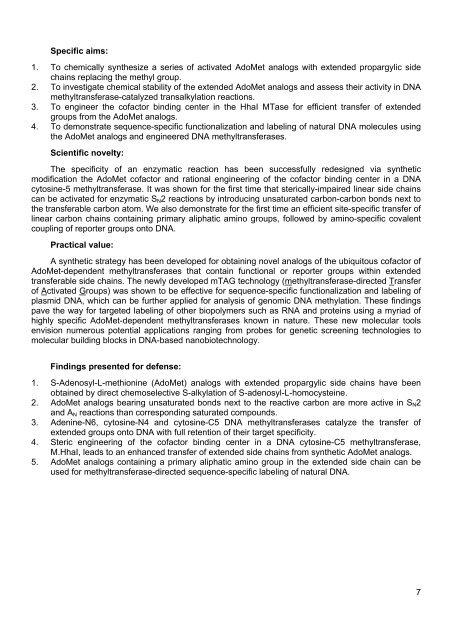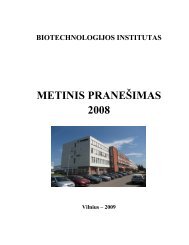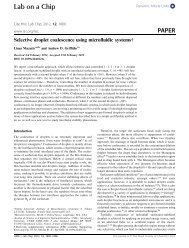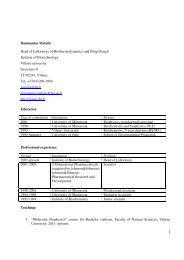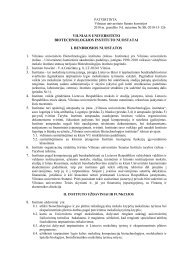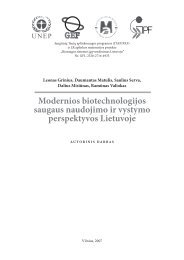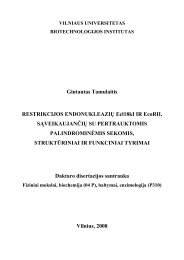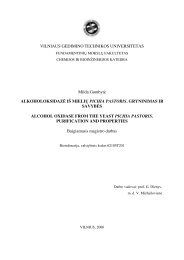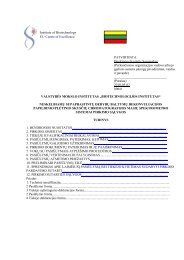INTRODUCTIONLiving organisms are dynamic systems of interacting biopolymers and their metabolites.Functional analysis of such systems often stands on the ability to specifically visualize selectedbiomolecules. To minimize possible artifacts, a small reporter group is to be attached to a selectedspecific position on a biomolecule under investigation. Several approaches for sequence-specific noncovalentlabeling of DNA have been proposed to date. However these techniques suffer from a majorproblem – the lack of tight coupling between a reporter moiety and its biological target, leading to highbackground and low detection sensitivity (Dirks et al., 2006; Ghosh et al., 2006). On the other hand,examples of sequence-specific covalent modification of DNA can be found in nature. The mostabundant covalent modification of DNA is methylation of nucleobases. It serves to expand theinformation content of the genome in organisms from bacteria to humans, and, for example, is part ofan intricate epigenetic regulatory network in higher vertebrates (Doerfler, 2006). The DNA methylationreactions are catalyzed by DNA methyltransferases – a class of enzymes that transfer a methyl groupfrom the ubiquitous cofactor S-adenosyl-L-methionine (AdoMet) onto predefined target sites on DNA.Despite the high importance of transmethylation reactions in biology, the transferred methyl group haslimited utility for practical applications. However, the ability of most MTases to catalyze highly specificcovalent modifications of biopolymers makes them attractive molecular tools, provided that transfer oflarger chemical entities can be achieved.Several attempts to achieve methyltransferase-directed transfer of extended groups from analogsof AdoMet have been reported. Early studies of AdoMet analogs (Parks, 1958; Schlenk et al., 1975) inwhich the transferable group on the sulfonium center is replaced by an extended aliphatic chainindicated that relatively short chemical groups, such as ethyl and propyl, can be transferred byMTases, but the transfer rates decline drastically as the size of the transferable group increases(methyl >> ethyl > propyl). This effect largely derives from destabilizing steric interactions in theextended aliphatic groups during nucleophilic substitution (S N 2) reactions. These early experimentsthus did not show much promise for targeted labeling of biomolecules using such extended AdoMetanalogs. The first success in covalent labeling of specific DNA sequences was achieved using N-aziridine cofactor mimics, which make use of a nucleophilic ring-opening reaction leading tomethyltransferase-directed coupling of the whole cofactor to DNA. By attaching chemical groups to theaziridine cofactors, they have been shown to work in combination with DNA MTases as deliverysystems for various functional or reporter groups. However, an inherent feature of this system is thatcovalent coupling of the two substrates leads to potent product inhibitors preventing further turnovers.Therefore, the DNA MTases have to be used in stoichiometric amounts with respect to their targetsites, and their tight association with the DNA may interfere with downstream applications (Pljevaljcicet al., 2004; Comstock et al., 2005; Klimasauskas et al., 2007).The above described problems prompted us to revisit the chemistry of sulfonium AdoMetanalogs. It is known that allylic and propargylic compounds are highly reactive in S N 2 reactions,suggesting that the rate of a methyltransferase-directed reaction can be enhanced by placingunsaturated bonds next to the transferable carbon in the extended side chains of AdoMet analogs.The goal of this work was to explore the potential of the propargylic system in transalkylationreactions catalyzed by AdoMet-dependent DNA methyltransferases. A series of AdoMet analogs withextended propargylic side chains have been chemically synthesized and examined in enzymaticreactions with all three types of DNA methyltransferases. The efficiency of transalkylation has beenfurther enhanced by rational engineering of the cofactor binding center in a model DNA cytosine-5methyltransferase, M.HhaI. This enzyme is a small protein that has been thoroughly characterized withrespect to the catalytic mechanism, interaction with cofactor and DNA (Wu et al., 1987; Cheng et al.,1993; Vilkaitis et al., 2001; Merkiene et al., 2005; Neely et al., 2005; Estabrook et al., 2006). Based onthe demonstrated methyltransferase-directed transfer of extended groups, a novel strategy forsequence-specific functionalization and labeling of DNA has been proposed.6
Specific aims:1. To chemically synthesize a series of activated AdoMet analogs with extended propargylic sidechains replacing the methyl group.2. To investigate chemical stability of the extended AdoMet analogs and assess their activity in DNAmethyltransferase-catalyzed transalkylation reactions.3. To engineer the cofactor binding center in the HhaI MTase for efficient transfer of extendedgroups from the AdoMet analogs.4. To demonstrate sequence-specific functionalization and labeling of natural DNA molecules usingthe AdoMet analogs and engineered DNA methyltransferases.Scientific novelty:The specificity of an enzymatic reaction has been successfully redesigned via syntheticmodification the AdoMet cofactor and rational engineering of the cofactor binding center in a DNAcytosine-5 methyltransferase. It was shown for the first time that sterically-impaired linear side chainscan be activated for enzymatic S N 2 reactions by introducing unsaturated carbon-carbon bonds next tothe transferable carbon atom. We also demonstrate for the first time an efficient site-specific transfer oflinear carbon chains containing primary aliphatic amino groups, followed by amino-specific covalentcoupling of reporter groups onto DNA.Practical value:A synthetic strategy has been developed for obtaining novel analogs of the ubiquitous cofactor ofAdoMet-dependent methyltransferases that contain functional or reporter groups within extendedtransferable side chains. The newly developed mTAG technology (methyltransferase-directed Transferof Activated Groups) was shown to be effective for sequence-specific functionalization and labeling ofplasmid DNA, which can be further applied for analysis of genomic DNA methylation. These findingspave the way for targeted labeling of other biopolymers such as RNA and proteins using a myriad ofhighly specific AdoMet-dependent methyltransferases known in nature. These new molecular toolsenvision numerous potential applications ranging from probes for genetic screening technologies tomolecular building blocks in DNA-based nanobiotechnology.Findings presented for defense:1. S-Adenosyl-L-methionine (AdoMet) analogs with extended propargylic side chains have beenobtained by direct chemoselective S-alkylation of S-adenosyl-L-homocysteine.2. AdoMet analogs bearing unsaturated bonds next to the reactive carbon are more active in S N 2and A N reactions than corresponding saturated compounds.3. Adenine-N6, cytosine-N4 and cytosine-C5 DNA methyltransferases catalyze the transfer ofextended groups onto DNA with full retention of their target specificity.4. Steric engineering of the cofactor binding center in a DNA cytosine-C5 methyltransferase,M.HhaI, leads to an enhanced transfer of extended side chains from synthetic AdoMet analogs.5. AdoMet analogs containing a primary aliphatic amino group in the extended side chain can beused for methyltransferase-directed sequence-specific labeling of natural DNA.7


